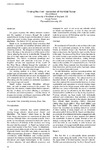Filming the river: memories of the tidal Tamar
| dc.contributor.author | Parker, Kayla | |
| dc.contributor.author | Moore, S | |
| dc.contributor.editor | Costa Valenta A | |
| dc.contributor.editor | Capucho R | |
| dc.date.accessioned | 2016-10-20T16:58:22Z | |
| dc.date.available | 2016-10-20T16:58:22Z | |
| dc.date.issued | 2016-09-01 | |
| dc.identifier.isbn | 978-989-96858-8-8 | |
| dc.identifier.uri | http://hdl.handle.net/10026.1/6579 | |
| dc.description | publication of conference paper in conference proceedings | |
| dc.description.abstract |
Our paper explores the affinity between location and the registers of memory through the material specificities of moving image and the place of cinema using two recent moving image artworks, Reach and Maelstrom: The Return (2014), as case studies. Reach is an ‘environmental’ direct animation that enables a symbiotic conversation between artist and place through film’s agency as a sensitive and sensible recording medium. The imagery is created by burying 16mm filmstrips in the alluvial mud of the banks of the Tamar, allowing the river to ‘make the film’ through the flow of its tidal waters and the action of the biota. In Maelstrom: The Return, mysterious upwellings and whirlpools flood with cinematic memories of long- forgotten arrivals and departures at the mouth of the River Tamar, effected through the ‘projection’ of archival home movie footage upon the substrate of un- still waters and the ‘sea of moving image’. Our working method is a close reading of our subject and an interaction with it. We critically reflect on the affective interplay of memory in our engagement with elemental forces of place and the materials of filmmaking and the audience’s embodied experience of moving image and sound. Reach makes memories, Maelstrom retrieves them, yet both re-create memory in the present. The tidal river, like cinema, creates intermittent movement, the flux of stasis and motion effecting a confluence of histories and lived experience – like the stream of images on a screen, creating an experience of film that is recognisable yet different each time. | |
| dc.format.extent | 140-144 | |
| dc.language.iso | en | |
| dc.publisher | Edições Cine-Club de Avanca | |
| dc.relation.ispartof | AVANCA | CINEMA 2016 | |
| dc.subject | anthropocene | |
| dc.subject | Film | |
| dc.subject | Materiality | |
| dc.subject | Memory | |
| dc.subject | new materialism | |
| dc.subject | River | |
| dc.subject | Tide | |
| dc.title | Filming the river: memories of the tidal Tamar | |
| dc.type | chapter | |
| plymouth.author-url | https://www.plymouth.ac.uk/staff/kayla-parker | |
| plymouth.edition | 7 | |
| plymouth.publisher-url | http://www.avanca.com/en | |
| plymouth.publication-status | Published | |
| plymouth.organisational-group | /Plymouth | |
| plymouth.organisational-group | /Plymouth/Faculty of Arts, Humanities and Business | |
| plymouth.organisational-group | /Plymouth/REF 2021 Researchers by UoA | |
| plymouth.organisational-group | /Plymouth/REF 2021 Researchers by UoA/UoA32 Art and Design: History, Practice and Theory | |
| plymouth.organisational-group | /Plymouth/Users by role | |
| plymouth.organisational-group | /Plymouth/Users by role/Academics | |
| dc.publisher.place | Avanca, Portugal | |
| dc.rights.embargoperiod | No embargo | |
| rioxxterms.licenseref.uri | http://www.rioxx.net/licenses/all-rights-reserved | |
| rioxxterms.type | Book chapter |


